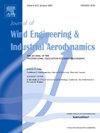Modeling of vortices in straight-line wind simulators
IF 4.2
2区 工程技术
Q1 ENGINEERING, CIVIL
Journal of Wind Engineering and Industrial Aerodynamics
Pub Date : 2025-02-01
DOI:10.1016/j.jweia.2024.105992
引用次数: 0
Abstract
A vortex is an important feature for wind engineering. This paper presents an experimentally validated technique to create vortices in straight-line wind simulators, advancing the study of transient flow features in traditional boundary layer wind tunnels. Repeatable translating vortices can be created in traditional atmospheric boundary layer wind tunnels by partially blocking off the tunnel's flow introducing horizontal shear instability. The technique is initially explored using computational fluid dynamics (CFD) simulations, followed by experimental validation at the University of Florida boundary layer wind tunnel. Findings validating the premise are observed concerning the radial profiles of (a) pressure, (b) velocity, and (c) vertical profile of velocity, which demonstrate the ability to create vortex characteristics comparable to that of specialized vortex simulators and field observations. This technique enables a realistic ratio of translation to tangential speed and swirl ratio of the vortices that conform well with full-scale measurements.
直线风模拟器中涡的建模
涡旋是风工程的一个重要特征。本文提出了一种在直线风模拟器中产生涡的实验验证技术,为传统边界层风洞瞬态流动特性的研究提供了新的思路。在传统的大气边界层风洞中,通过部分阻挡风洞气流,引入水平剪切不稳定,可以产生可重复的平移涡。该技术最初通过计算流体动力学(CFD)模拟进行了探索,随后在佛罗里达大学边界层风洞进行了实验验证。在(a)压力的径向分布、(b)速度的径向分布和(c)速度的垂直分布中观察到验证前提的发现,这些发现证明了创建涡特征的能力,可与专门的涡模拟器和现场观测相媲美。该技术可以使旋涡的平移速度与切向速度的比值和旋流比符合全尺寸测量。
本文章由计算机程序翻译,如有差异,请以英文原文为准。
求助全文
约1分钟内获得全文
求助全文
来源期刊
CiteScore
8.90
自引率
22.90%
发文量
306
审稿时长
4.4 months
期刊介绍:
The objective of the journal is to provide a means for the publication and interchange of information, on an international basis, on all those aspects of wind engineering that are included in the activities of the International Association for Wind Engineering http://www.iawe.org/. These are: social and economic impact of wind effects; wind characteristics and structure, local wind environments, wind loads and structural response, diffusion, pollutant dispersion and matter transport, wind effects on building heat loss and ventilation, wind effects on transport systems, aerodynamic aspects of wind energy generation, and codification of wind effects.
Papers on these subjects describing full-scale measurements, wind-tunnel simulation studies, computational or theoretical methods are published, as well as papers dealing with the development of techniques and apparatus for wind engineering experiments.

 求助内容:
求助内容: 应助结果提醒方式:
应助结果提醒方式:


